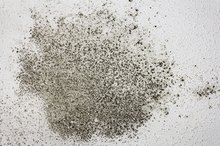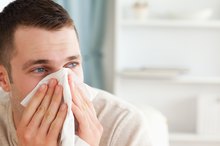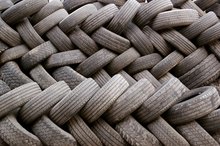What does fact checked mean?
At Healthfully, we strive to deliver objective content that is accurate and up-to-date. Our team periodically reviews articles in order to ensure content quality. The sources cited below consist of evidence from peer-reviewed journals, prominent medical organizations, academic associations, and government data.
The information contained on this site is for informational purposes only, and should not be used as a substitute for the advice of a professional health care provider. Please check with the appropriate physician regarding health questions and concerns. Although we strive to deliver accurate and up-to-date information, no guarantee to that effect is made.
Side Effects of Mold Inhalation
Molds are organisms that reproduce by releasing spores that create mold colonies when the spores settle on damp surfaces. The increased number of mold colonies can destroy the surfaces they feed off of and digest. During their life cycle, mold colonies can cause significant medical problems. These can be reactions to the spores or to mycotoxins, which are dangerous chemical byproducts of mold that, according to the National Institutes of Health, can cause death in humans and animals 2. Mold inhalation can be dangerous and can cause chronic side effects.
If you are experiencing serious medical symptoms, seek emergency treatment immediately.
Allergic Reactions
Mold inhalation can cause allergic reactions, even in people who have not previously had allergies. Continued exposure, according to the Environmental Protection Agency, can lead to increased sensitivity and worsening of symptoms 1. Allergic reaction to mold can cause headaches, sneezing, runny nose and hives, which are indications of a histamine response to an allergen. In addition, inhaling mold spores can irritate the bronchial tract and trigger asthma attacks.
- Mold inhalation can cause allergic reactions, even in people who have not previously had allergies.
- Continued exposure, according to the Environmental Protection Agency, can lead to increased sensitivity and worsening of symptoms 1.
Hypersensitivity Pneumonitis
Diseases Linked to Black Mold
Learn More
Hypersensitivity pneumonitis is a lung disease characterized by inflammation of the lungs. Chronic hypersensitivity pneumonitis can lead to scarring of the lungs, an irreversible condition that decreases lung capacity. Acute hypersensitivity pneumonitis produces fever, chills and coughing and generally resolves on it's own, once the individual is no longer exposed to the mold.
Sinusitis
Sinusitis is caused by inhalation of an irritant. Mold spores enter the nasal cavity and migrate to one of four sinus cavities. The tissues of the sinuses become inflamed and swollen, and the ensuing pressure causes pain. A person suffering from sinusitis experiences sinus headaches and nasal discharge and these can lead to infection.
- Sinusitis is caused by inhalation of an irritant.
- The tissues of the sinuses become inflamed and swollen, and the ensuing pressure causes pain.
Cognitive and Mood Problems
What Are the Signs of Mold Sickness?
Learn More
Exposure to mold, according to the Florida Department of Health, can cause cognitive problems such as memory loss and mood swings 3. In some individuals, these can lead to depression, fatigue and loss of interest in everyday activities. Mycotoxins can cause sleep disturbances and if left untreated, can lead to neurological problems such as impaired balance and difficulty walking.
- Exposure to mold, according to the Florida Department of Health, can cause cognitive problems such as memory loss and mood swings 3.
- Mycotoxins can cause sleep disturbances and if left untreated, can lead to neurological problems such as impaired balance and difficulty walking.
Mycotoxins
Mycotoxins, according to the "Journal of Environmental Health," can become embedded in the mucous membrane lining of the digestive system 2. This can cause symptoms such as diarrhea, nausea, vomiting, internal hemorrhaging and abnormal liver values. If your body is already immunocompromised by these symptoms, you are at increased risk of a systemic infection, which is potentially fatal.
Related Articles
References
- Environmental Protection Agency: Introduction to Molds
- National Institutes of Health: Mycotoxins
- Florida Department of Health: Indoor Mold and Health
- Amirhosein Ghaffarianhoseini, Husam AlWaer, Hossein Omrany, Ali Ghaffarianhoseini, Chaham Alalouch, Derek Clements-Croome & John Tookey (2018) Sick building syndrome: are we doing enough?. Architectural Science Review,61:3, 99-121.
- American College of Allergy, Asthma & Immunology. Mold Allergy. Reviewed April 23, 2018.
- Centers for Disease Control and Prevention. Fungal Diseases. Reviewed May 6, 2019.
- Centers for Disease Control and Prevention. Mold. Basic Facts. Reviewed December 20, 2017
- Asthma and Allergy Foundation of America. Mold Allergy. Reviewed October 2015.
- Centers for Disease Control and Prevention. Molds in the Environment. Rreviewed December 20, 2017.
- Asthma and Allergy Foundation of America, Mold Allergy
- Centers for Disease Control and Prevention (CDC), Mold, Basic Facts
- Rudert A, Portnoy J.Mold allergy: is it real and what do we do about it?Expert Rev Clin Immunol. 2017 Aug;13(8):823-835. doi: 10.1080/1744666X.2017.1324298. Epub 2017 May 17.
Writer Bio
Maura Banar has been a professional writer since 2001 and is a psychotherapist. Her work has appeared in "Imagination, Cognition and Personality" and "Dreaming: The Journal of the International Association for the Study of Dreams." Banar received her Bachelor of Arts in psychology from Buffalo State College and her Master of Arts in mental health counseling from Medaille College.








